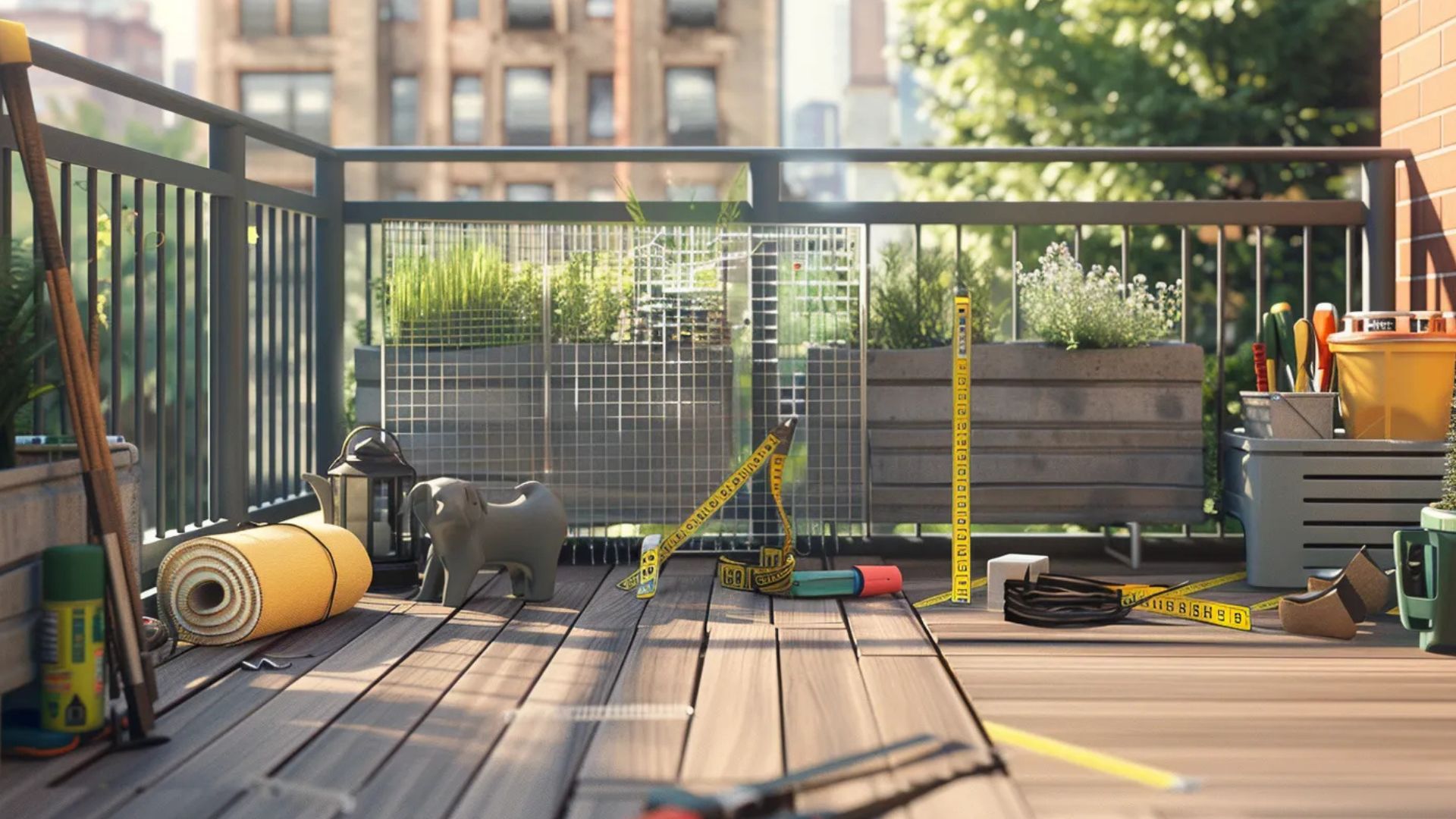Pets can face serious dangers on decks without proper barriers. This article explores the importance of pet safety deck barriers, providing insights on how to assess your deck’s design, select the appropriate type of barrier, and ensure safe installation. Readers will learn practical tips to enhance their pets’ safety while enjoying outdoor spaces. By understanding these elements, pet owners can prevent accidents and create a secure environment for their furry companions.
Key Takeaways
- Pet safety deck barriers prevent accidents by keeping pets secure on elevated surfaces
- Various materials, like wood and metal, offer unique benefits for different outdoor settings
- Accurate measurements are essential for ensuring proper fitting and effective barrier installation
- Regular maintenance and inspections prolong the life of pet safety barriers, ensuring reliability
- Training techniques help acclimate pets to barriers, promoting their safety and comfort outdoors
Understand the Importance of Pet Safety Deck Barriers

Pet safety deck barriers are essential for maintaining a secure environment for pets in outdoor settings. These barriers are part of child and pet safe deck railing solutions and not only enhance usability by preventing pets from accidentally falling off balconies or decks but also come in various types, including gates and wood options, to suit different needs. The benefits of installing these barriers extend to safety, peace of mind, and an overall improved experience for both pets and their owners.
Why Pet Safety Deck Barriers Are Necessary for Your Home
Pet safety deck barriers serve as a crucial line of defense, reducing the risk of accidents by preventing pets from falling off elevated surfaces. For homes with yards, the installation of a sturdy pet fence not only enhances safety but also complements the construction aesthetics of outdoor spaces. With the right barriers in place, pet owners can enjoy their time outdoors without the constant worry of their furry companions roaming too close to edges or unsafe areas.
Common Types of Pet Safety Deck Barriers Available
When considering pet safety deck barriers, various materials and designs are available to cater to different needs and preferences. Concrete barriers provide a sturdy option that can withstand pressure, making them suitable for high-energy pets. Metal barriers, on the other hand, offer durability and security, ensuring that pets remain safely contained while enhancing the visual appeal of outdoor spaces. Understanding these options allows pet owners to make informed decisions about implementing safety measures for their pets.
- Concrete barriers offer stability and resilience for energetic pets.
- Metal barriers provide durability and an aesthetic appeal.
- Variety in materials enables customization for individual needs and policies.
Benefits of Installing Pet Safety Deck Barriers
Installing pet safety deck barriers provides numerous benefits that directly enhance the well-being of pets and their owners. These barriers significantly reduce the likelihood of accidents, allowing pets to enjoy outdoor spaces while remaining secure. Furthermore, they offer peace of mind, enabling pet owners to relax without constantly worrying about their pets’ safety near elevated surfaces:
| Benefit | Description |
| Accident Prevention | Reduces the risk of pets falling from decks or balconies. |
| Peace of Mind | Allows pet owners to relax outdoors without anxiety about their pets’ safety. |
| Improved Outdoor Experience | Enhances the overall enjoyment of outdoor spaces for both pets and owners. |
A safe space for pets starts with the right design. Next, it is time to look closely at your deck and see how to best install those barriers.
Assess Your Deck’s Design for Barrier Installation

Evaluating the deck materials and structure is essential for determining the suitability and effectiveness of pet safety barriers. Accurate measurements of the deck area are necessary for proper sizing, while identifying potential access points for pets ensures comprehensive coverage. Each of these considerations plays a critical role in optimizing safety and functionality when installing barriers on outdoor spaces.
Evaluating Deck Materials and Structure
Evaluating the materials and structure of a deck is essential before installing pet safety barriers. Understanding how the deck is constructed can help determine the most appropriate type of barrier to ensure stability and security. For instance, a wood deck may require different fastening techniques compared to a concrete deck, thereby influencing the design and placement of safety barriers that effectively safeguard pets from potential falls.
Measuring the Deck Area for Accurate Barrier Sizing
Accurate measurements of the deck area are crucial for selecting the appropriate size and type of pet safety barriers. By measuring the length and height of the deck’s perimeter, pet owners can ensure that barriers provide adequate coverage while maintaining structural integrity. Additionally, taking precise measurements can help identify any unique features of the deck that may affect the installation process, ultimately leading to a safer environment for pets while enjoying outdoor spaces.
Identifying Potential Access Points for Pets
Identifying potential access points for pets is a critical step in enhancing the safety of outdoor spaces. Pet owners should carefully examine deck areas to spot gaps, openings, or weaknesses that might allow pets to slip through or navigate around barriers. Common access points may include spaces between railings, stairs, or under the deck itself, where small animals could escape or get trapped. Recognizing these areas enables homeowners to take preventive measures, ensuring that pet safety deck barriers are fully effective:
| Access Point | Potential Risk |
| Gaps Between Railings | Pets may squeeze through and fall off the deck. |
| Stairs | Pets can easily slip down or escape if barriers are not properly installed. |
| Under Deck Areas | Small pets could hide or become stuck, compromising their safety. |
Once the design is clear, focus on choosing the right barrier. The right choice can change everything for your deck and your pets.
Select the Right Type of Barrier
Selecting the appropriate type of pet safety deck barrier involves comparing various materials and designs that suit specific needs and preferences. Factors such as durability, ease of installation, and aesthetics play a significant role in making an informed choice. Furthermore, understanding local regulations and requirements is essential to ensure compliance and enhance safety when safeguarding pets in outdoor areas.
Comparing Various Barrier Materials and Designs
When selecting a pet safety deck barrier, it is vital to consider the various materials and designs available to ensure optimal protection for pets. Common options include metal, wood, and vinyl, each offering unique advantages such as durability and aesthetic appeal. For example, metal barriers provide robust security that can withstand active pets, while wooden barriers can blend seamlessly into a natural outdoor environment, offering both safety and visual harmony.
| Material | Advantages |
| Metal | High durability and security for energetic pets. |
| Wood | Aesthetic appeal and natural integration with outdoor spaces. |
| Vinyl | Low maintenance and weather-resistant, ideal for diverse climates. |
Factors to Consider When Choosing a Barrier Style
When selecting a barrier style for pet safety on decks, several factors warrant consideration to ensure optimal effectiveness and aesthetics. The durability of the material is paramount, as high-energy pets require barriers that can withstand wear and tear. Additionally, the design should align with the overall aesthetic of the home and outdoor space, promoting harmony while providing security. Understanding local building codes and necessary safety regulations also plays a critical role in making an informed choice that guarantees compliance and enhances the safety of pets in elevated environments.
Understanding Local Regulations and Requirements
Understanding local regulations and requirements is vital when selecting pet safety deck barriers. Different jurisdictions may have specific guidelines regarding barrier height, material standards, and installation practices to ensure safety and compliance. Homeowners should consult local building codes or zoning regulations to confirm that their chosen barriers meet all legal standards, thereby enhancing safety for pets and offering peace of mind for owners.
Choosing the right barrier is just the beginning. The way it is installed will determine its strength and effectiveness, so attention to the details matters.
Focus on Installation Techniques
Preparing the deck for barrier installation is essential for ensuring safety and durability. This section outlines a step-by-step guide for installing various barrier types, detailing approaches unique to each material. Additionally, it highlights the necessary tools and materials for a successful installation, offering practical insights to enhance the effectiveness of pet safety deck barriers.
Preparing the Deck for Barrier Installation
Preparing the deck for barrier installation is a fundamental step in ensuring the effectiveness of pet safety measures. First, it’s vital to clean the deck surface thoroughly, removing any debris or loose boards that could interfere with the installation process. Next, assessing the structural integrity of the deck will help identify any necessary repairs before barriers are set up, ensuring a secure and stable environment for pets.
- Clean the deck surface to ensure proper installation.
- Inspect the deck for any structural integrity issues.
- Make necessary repairs before installing barriers.
Step-by-Step Guide to Installing Different Barrier Types
Installing pet safety deck barriers requires careful planning and execution to ensure optimal effectiveness. First, it is essential to gather the necessary materials and tools specific to the chosen barrier type, whether it be wood, metal, or vinyl. For instance, wooden barriers may require screws and brackets, while metal options may need welding equipment. Proper alignment during installation is crucial to maintain stability and prevent pets from pushing against or squeezing through the barriers. By following these steps and ensuring meticulous attention to detail, homeowners can create a safe outdoor environment that effectively protects their pets.
Tools and Materials Needed for Installation
For a successful installation of pet safety deck barriers, homeowners need an assortment of tools and materials tailored to the chosen barrier. Essential items typically include a drill or screwdriver, measuring tape, level, and safety gear such as gloves and goggles. Selecting high-quality materials, such as durable screws for wooden barriers or heavy-duty brackets for metal options, can significantly impact the overall effectiveness and longevity of the installation, ensuring the safety of pets in outdoor spaces.
Proper installation ensures the barrier stands strong against wear and tear. With these techniques in place, attention must shift to safety and durability to protect what matters most.
Ensure the Safety and Durability of the Barrier
Securing pet safety deck barriers effectively is vital for ensuring their long-term durability and reliability. Homeowners should implement regular maintenance practices to prolong the life of these barriers while also identifying and addressing any weak points that may arise over time. This section will provide practical tips for securing barriers, maintenance strategies, and how to recognize potential vulnerabilities, ultimately enhancing pet safety in outdoor areas.
Tips for Securing the Barrier Effectively
To secure pet safety deck barriers effectively, homeowners should anchor the barriers firmly to prevent any movement that could arise from a pet’s pressure. Utilizing high-quality fasteners specific to the material type is essential for ensuring stability, while regular inspections will help identify wear or loosening over time. By addressing these aspects diligently, pet owners can significantly enhance the durability and reliability of their barriers, providing a safe environment for their pets in outdoor settings.
Regular Maintenance Practices for Longevity
Implementing regular maintenance practices is essential for ensuring the longevity of pet safety deck barriers. Homeowners should periodically inspect the barriers for signs of wear, such as loose connections or rust on metal components, and address any issues immediately to maintain a secure environment. Additionally, cleaning the barriers regularly helps prevent the buildup of dirt and debris, which can compromise their effectiveness over time:
| Maintenance Task | Description |
| Regular Inspections | Check for loose connections, rust, or any signs of damage. |
| Cleaning | Remove dirt and debris to maintain barrier integrity. |
| Repair | Address any identified issues promptly to ensure safety. |
Identifying and Addressing Weak Points in the Barrier
To maintain the effectiveness of pet safety deck barriers, it is essential to regularly identify and address weak points that may compromise their integrity. Homeowners should conduct thorough inspections of the barriers, focusing on areas where materials may show signs of wear or joints may weaken over time. By promptly reinforcing or repairing these vulnerabilities, pet owners can ensure a robust barrier system that protects their animals from potential accidents, ultimately fostering a safer outdoor environment.
To keep pets safe, it is not enough to build a strong barrier. Training them to understand this boundary will deepen their respect for it.
Educate Your Pets for Safe Interaction With Barriers
Training techniques are vital for acclimating pets to new barriers, helping them understand boundaries while promoting safety. Monitoring pets’ behavior around these barriers ensures effective adaptation and minimizes risks. Additionally, adjusting to pets’ needs and preferences over time enhances their comfort. Together, these strategies foster a secure environment that protects pets while allowing them to enjoy outdoor spaces.
Training Techniques to Acquaint Pets With New Barriers
Acclimating pets to new barriers involves consistent training techniques that integrate positive reinforcement. For instance, pet owners can introduce their animals to the barriers gradually, using treats and praise to reward them for approaching or respecting the boundaries. Over time, this method helps pets develop an understanding of their limits, ensuring they feel secure while enjoying outdoor areas.
- Introduce barriers gradually to pets using treats.
- Use positive reinforcement to reward desired behavior.
- Monitor and adjust training based on pets’ comfort levels.
Monitoring Pets’ Behavior Around Barriers
Monitoring pets’ behavior around barriers is crucial for ensuring their safety and comfort. By observing how pets interact with the deck barriers, owners can identify any anxiety or confusion that may arise, enabling timely adjustments to training or barrier design. For example, if a pet appears hesitant or attempts to escape, it may indicate the need for a more secure barrier or additional training to reinforce boundaries, thereby enhancing overall safety for both pets and their owners.
Adjusting to Pet Needs and Preferences Over Time
Adjusting to pets’ needs and preferences over time is essential for maintaining their safety and comfort around barriers. Pet owners should regularly assess their animals’ behavior, noticing how they respond to the installed safety measures. For instance, if a pet exhibits signs of anxiety or attempts to navigate around the barriers, owners may need to modify training techniques or reinforce the boundaries to ensure a secure environment.
| Observation | Action |
| Pet shows anxiety near barriers | Reinforce training with positive reinforcement and rewards. |
| Pet attempts to escape | Consider enhancing barrier security or adding additional barriers. |
| Pet adapts well to barriers | Continue to monitor their behavior but maintain current setup. |
Pet safety deck barriers play an essential role in providing a secure environment for animals in outdoor settings, significantly reducing the risk of accidents. By selecting the appropriate type and effectively installing these barriers, pet owners can enjoy peace of mind while their pets roam freely. Regular maintenance and awareness of their pets’ behavior further enhance the effectiveness of these safety measures. Prioritizing pet safety through proper barrier implementation is vital for a safe and enjoyable outdoor experience for both pets and their owners.


Recent Comments